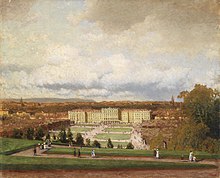Schönbrunn German

Schoenbrunn German is that form of High German that was spoken from the late 18th century at the imperial court in Vienna. Schönbrunn German is a sociolect , i.e. a language form of a certain group (e.g. age group) that is generally based on social factors. It was spoken by the imperial family, the nobility and the Viennese upper middle class. The way of speaking of the imperial court was a language standard for the spoken German in Austria-Hungary .
It is named after Schönbrunn Palace in the 13th district of Hietzing in Vienna . Most of the speakers can also be found in the district.
The Schönbrunn German is an almost extinct sociolect, but it shows some interesting facets of the German language. Schönbrunner German can be recognized by the special emphasis on certain letters as well as elongations and shortenings. This sociolect also has a very specific language pace.
Examples
- Otto von Habsburg
- Emperor Karl I (1916–1918)
- Emperor Franz Joseph (1848–1916)
Individual evidence
- ^ Otto von Habsburg: Quo vadis integration? Ceremonial lecture Eggenberg 2004
- ↑ Sound document of Emperor Karl I.
- ↑ Sound document of Emperor Franz Joseph I.